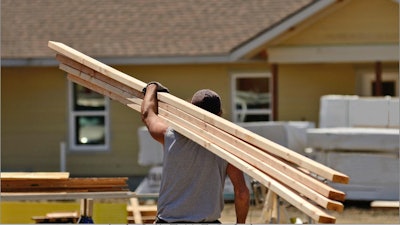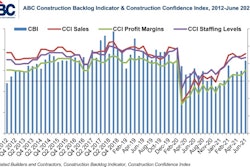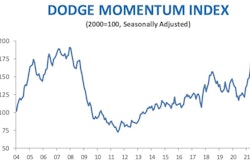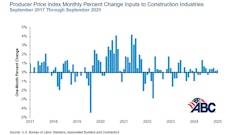
Lumber’s hundreds-of-percent spike in the past year made a big splash. It is said to be capable of adding $36,000 to the price of a typical single-family, it has slowed and even cancelled some construction, and it has even some small-government types crying for federal intervention.
Lumber prices’ precipitous fall this month hardly generated as much hullaballoo. To be fair, actual selling prices are still quite high, and some lumber prices have stubbornly resisted change.
But the economy at large, lead in part by the Federal Reserve, likes what it sees in lumber today, calling it an example of supply and demand rationally correcting to prevent runaway inflation.
How corrected are prices, really?
The Wall Street Journal this week reported wood-pricing service Random Lengths’ framing lumber composite index dropped to $1,010, down from $1,210 a week ago. That’s a third less than when the index topped out at $1,515 late in May. Yet lumber prices remain sky high – the spot-price index was $459 a year ago and despite a dramatic tumble.
Lumber futures are down more than 45% from their peak, below $900 this week for the first time in months. The sell-off has been gaining momentum, but between 2009 and 2019, futures averaged less than $400 per thousand board feet.
Builders are, understandably, not dancing in the streets, after a few weeks of correction to prices that are still two to three times normal.
“Despite the drop in prices, suppliers and manufacturers still have leverage – especially in the South Florida market – to keep pricing quotes high,” Adam Mopsick, CEO of South Florida-based general contractor Amicon told GlobeSt.com. “Our project managers are currently not considering this long term and continue to strategize project budgets to include higher pricing as the demand continues to soar in local markets like luxury residential and ground-up commercial development.
“Other essential commodities such as copper, aluminum and steel have not experienced the same declines, and we anticipate that this volatility may continue as the construction market levels out to meet the construction surge.”
Prices for oriented strand board, or OSB, persist at record highs, in part due to a winter storm in Texas that reduced supplies of resin needed to make the bonded wood-chip sheeting, according to Bloomberg.com. From Western Canada to the Southeast U.S., mills are selling 7/16ths OSB sheeting at record levels -- $1,700 to $1,160 per 1,000 square feet, respectively. Order deliveries are taking two to four weeks, Random Lengths data show.
"I used to buy OSB for $12 a sheet," builder Joe Gromofsky told ABC affiliate News5 Cleveland. "Now it's over $48 ... I mean it's terrible. It jumped four times. 400%."
Who can do something about it?
Trade negotiations don’t seem likely to do anything about lumber prices soon, according to a report by Politico.com.
The British Columbia Lumber Trade Council is pressing the U.S. to repay Canadian producers billions of dollars they’ve paid to U.S. customs authorities as part of anti-dumping and countervailing duties imposed on Canadian lumber by the Trump administration in 2017. They also want the tariffs removed.
The U.S. Lumber Coalition, which accuses Canada of unfair trading practices that have destroyed American jobs, says it is “open to a new U.S. – Canada softwood lumber trade agreement if and when Canada can demonstrate that it is serious about negotiations.”
The primary bone of contention seems to be the "stumpage fees" Canadian provinces charge lumber companies to cut trees on public lands. The U.S. contends those are set at below-market rates and constitute an unfair government subsidy.
The U.S. Commerce Department legally determined that Canada is subsidizing its lumber exports and selling them at unfairly low prices. And the U.S. International Trade Commission also found the domestic industry was harmed by Canadian trade practices.
A good sign, nevertheless
Lumber prices’ past month is being held up as a lesson in how supply and demand should react to release from pandemic lockdown, counteracting warnings about runaway inflation.
The New York Times offers an interesting take on what’s happened since May, when the Consumer Price Index rose 5% compared with a year earlier — the fastest pace in 13 years – pointing out that runaway inflation like that seen in the late 1960s and 1970s is psychological as much as an economic. People convinced that prices are on a never-ending escalator rush to buy now, at any price, and price-increase forecasts become a self-fulfilling prophecy.
The lumber market’s behavior in June is seen as a sign of consumer sanity.
“We don’t have that kind of buying frenzy that creates sustained inflation,” Kristina Hooper, chief global market strategist at the investment management firm Invesco, told the Times. “To me, this is very, very different than the 1970s.”
Officials at the Federal Reserve agree. They’ve long argued that any price rise would be temporary.
“Our expectation is that these high inflation readings that we’re seeing now will start to abate,” Fed chair, Jerome H. Powell, said at a news conference after the central bank’s most recent decision to leave interest rates unchanged. “That’s what we think. And it’ll be like the lumber experience.”




















